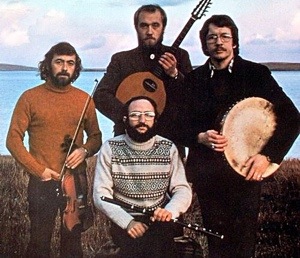The Boys of the Lough have, over four decades, become a byword for excellence in Irish, Shetland and Scots music. Energised for much of that time by the quicksilver fiddle and flute front line of Aly Bain and Cathal McConnell, the Boys were pioneers, both in their musical approach and as the first fully professional touring “Celtic” band, opening up an international touring circuit for the many Scots and Irish bands who would follow.
Read more about the Scottish Traditional Music Hall of Fame.
The group’s origins lay in a trio of two Fermanagh musicians, flautist and singer Cathal McConnell and, from an older generation, fiddler Tommy Gunn, and an energetic student, singer and concertina and bodhran player from Portadown, Robin Morton. They started playing together in Northern Ireland in1967 then toured Britain at the behest of Ewan McColl. They were looking for a snappier moniker than their three names crammed on to a poster, when the organiser of Aberdeen Folk Festival, the late Peter Hall, suggested the Boys of the Lough, the title of a reel from Tommy’s repertoire.
It was also at the Aberdeen festival that the trio first caught sight and sound of a superb young fiddler in winklepicker shoes – one Aly Bain, recently arrived from Shetland. After the older Gunn retired from travelling, Morton, who had arrived in Edinburgh to do his PhD, and McConnell started gigging together and encountered the recently formed duo of Bain and guitarist and singer Mike Whellans. In session, the four of them gelled wonderfully and they tentatively started touring together, with each duo performing a set, then teaming up as a quartet for the finale, under the Boys of the Lough banner.
The excitement generated by this serendipitous combination was palpable. The Boys’ ground-breaking emphasis on integrating virtuoso playing with songs and a seemingly spontaneous presentation was a winner and the group’s appearance at the 1972 Cambridge festival a triumph. “Nobody was playing tunes at that level like Bain and McConnell,” Morton would later say. “At times the hair stood up on the back of my neck listening to them.
“We all knew that this music had the ability to entertain,” he recalls, “but it wasn’t being heard, and we put it out there.”
Aly and Mike had already visited America and the quartet followed suit. Just as the Boys’ first album was due for release, Whellans left to pursue a solo career and his place was taken by singer-guitarist Dick Gaughan (whose features had to be superimposed over those of Whellans on the scarcely dry sleeve painting).
In 1973, Gaughan left, to be replaced by Northumbrian multi-instrumentalist Dave Richardson, who became a long-standing fixture in the line-up, which would continue to change over the years. In the meantime, not only were they blazing a musical trail across the States, but also packing ‘em into such unlikely venues as London’s Festival Hall and the Usher Hall in Edinburgh.
Morton left in 1979, going on to establish Temple Records and manage the Battlefield Band, while Richardson took on the running of the group. Other members over the ensuing years included Dave’s brother, the late Tich Richardson, and two more Irishmen – piper and singer Christy O’Leary and pianist John Coakley.
The gruelling US tours continued, with well over 70 chalked up to date, one American writer hailing the Boys as “illustrious ambassadors from the Celtic world”, while in 1981 they were made honorary citizens of El Paso in Texas, the first of many such honours from North-American audiences. Their Live at Carnegie Hall album of 1989, captured their show at the hallowed New York venue, drolly compered by Garrison Keillor, of Prairie Home Companion fame. Further demand saw their blend of predominantly Irish but also Shetland and Scots repertoire enthusiastically received in the Antipodes and the Far East.
After more than three decades, Bain left in 2002 to pursue other activities, particularly his playing partnership with Phil Cunningham, the fiddle chair taken by another fine young Shetland player, Kevin Henderson. By this time Richardson and McConnell had been joined by the formidable Kerry accordionist and singer Brendan Begley, along with Scots guitarist and bouzouki player Malcolm Stitt. After ten years with the band, Stitt left in 2008, to be replaced by Clare multi-instrumentalist Garry O’Briain.
In 2010, McConnell’s inestimable contribution to traditional music through his playing and singing and his vast store of songs and tunes was recognised by a prestigious Gradam Ceóil award from TG4, the Irish Gaelic TV channel, with some of the Boys playing at the award ceremony.
Following Richardson’s retirement two years ago, the band, with 21 albums under its collective belt, has seen a relatively fallow period but at the time of this award was planning a new recording for 2014 and yet another American tour, with a line-up of Henderson, Begley, O’Briain and the sole remaining founder member, Cathal McConnell, continuing to draw on his mighty store of tunes and songs.
